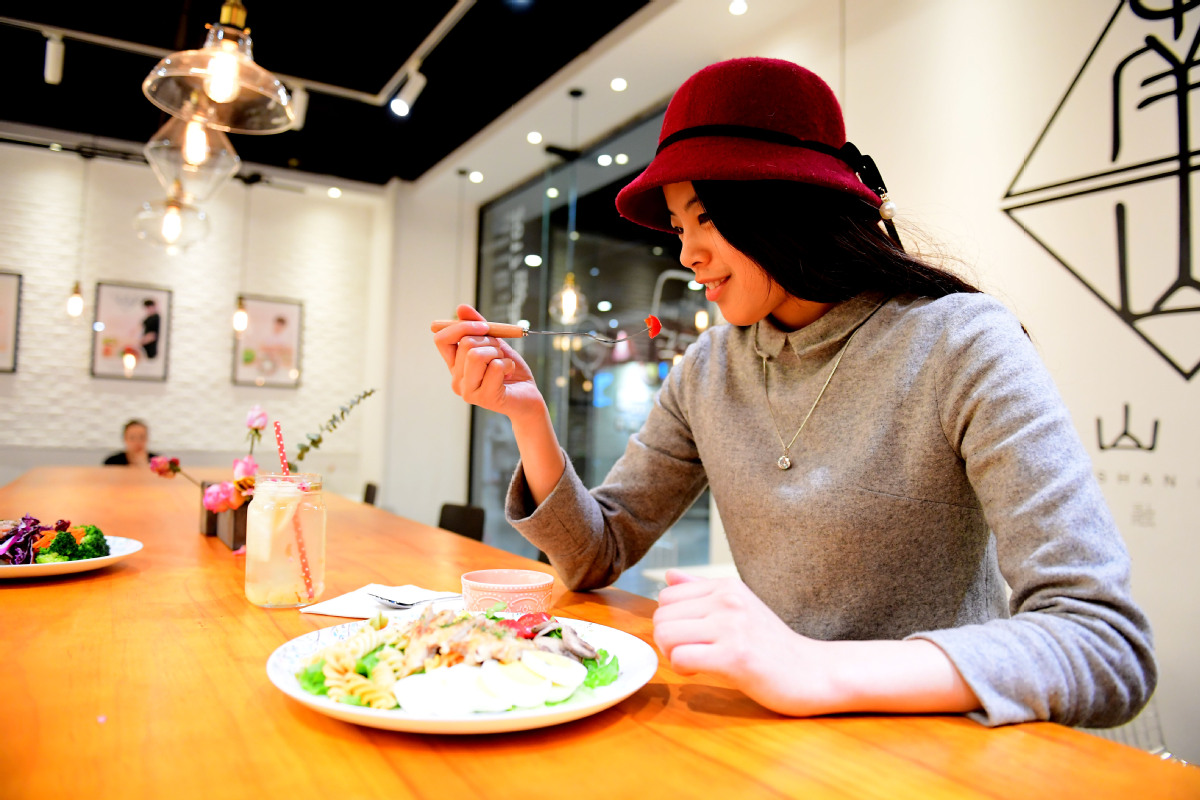Light meals segment heavy with big hopes for the future
By Chen Meiling | China Daily | Updated: 2019-03-04 13:51

Health-conscious consumers stoke demand for nutritional foods, spawn huge market
Health-and weight-conscious Zou Jing, 44, a college teacher in Wuhan, Hubei province, spends up to 150 yuan ($22.4) on three "light meals" a week.
Zou is among millions of Chinese consumers, especially the younger generation born in the 1990s, who are embracing nutritional lifestyles that are creating high demand, and a big market, for light meals.
These are foods low on sugar and fat, and high on cellulose and protein - salads, vegetable juices and cereals - which are said to be good for building muscle, cutting down on fat and losing excess body weight while giving a sense of satiety.
By 2022, the market size for such foods is expected to exceed 100 billion yuan. By 2024, the segment is expected to contribute 10 percent of the total revenue of China's catering market, industry data showed.
Unsurprisingly, investors are making a beeline for this segment, exploring avenues like specialty restaurants and food supply firms. During the week-long Spring Festival holiday in early February, online orders for light meals grew 47 percent year-on-year, according to a report from internet giant Alibaba.
Consumers such as Zou are responsible for this trend. "After eating several light meals, I felt my appetite has shrunk. I now prefer light flavors," she said, sharing an image of her lunch - a mixture of corn kernels, mushroom, eggs, cherry tomatoes, beef and mashed potato.
"The only problem is that salad cannot warm up my body like hot dishes in winter."
Derek Deng, partner of consultancy Bain & Company, said: "Consumers are putting more emphasis on health and well-being. It's a trend shared across the world.
"In China, pursuit of beauty and a good body shape, especially among the millennials, is bringing glad tidings to the light diet business."
Westerners' preference for fresh, organic, chilled and additive-free food is influencing the eating habits of Chinese, who traditionally chose deep-fried dish and various condiments, he said.
It takes time for more consumers to join, but the wave has been spreading from first-tier cities to second-and third-tier cities over the last five years, Deng said.
Restaurants, cafes, online retailers and other startups are entering the segment.
For instance, KFC opened in 2017 its first green restaurant called Kpro in Hangzhou, Zhejiang province, and another one in Beijing in August last year. There, KFC sells salads, juices and sandwiches.
Luckin Coffee jumped on the light meals bandwagon in August. Gaga cafe, a light meal chain brand, received 180 million yuan in its A-round financing last year.
According to a report in National Business Daily, the concept of light meals originated in Europe, and became popular in China in 2014.
About 70 percent of light meal consumers in China are women aged 22 to 35, who are all served by about 3,000 firms of various kinds (restaurants, stores, food makers, distributors and so on). About 10 of them received big-ticket financing from investors over the last five years, the NBD report said.
Bian Rongrong, 35, opened a 70-square-meter light meal restaurant at the Optics Valley, a major commercial center in Wuhan, in June 2018.
She invested more than 100,000 yuan in joining a Shanghai-based chain brand, and on decorating the restaurant and buying the necessary equipment.
Operational costs include rental of up to 20,000 yuan per month, salaries of five workers and raw food materials of about 15 yuan per dish.
A bowl of salad retails for about 40 yuan. Monthly sales, from both online and offline orders, reach about 2,000 yuan during the peak season (April to October), when temperatures are high.
Though the store is yet to break even, Bian said she is optimistic about the future. "Many people these days have health problems such as hyperlipidemia, high blood pressure and high blood sugar. So consumption of light meals will become a trend."
To ride the anticipated trend, light meal retailers such as Liu Ning of Beijing are preparing in advance. Liu is working toward opening his third store.
His first store opened in 2017, and broke even in its fourth month. It sells about 8,000 light meals online every month. Besides, each of his shops receives about 20 in-store orders a day on average. He has already received the support of some individual investors.
Other retailers of light meals may not be that lucky. Before the Spring Festival holiday in February, there were about 40 light meal stores around Wangjing, where one of Liu's stores is located. Only about 10 remained in business after the festival, Liu said.
Regular catering businesses, such as hotpots, have a mature business model while light meal shops lack a proven model and well-known brands, he said. "But that also suggests there is an opportunity to explore a new and innovative model."
Liu is planning to open a diet bar beneath a gym. The two businesses would share not only clients but revenue.
Chen Yu, an analyst from market research firm Analysys, said the light meals segment is attracting many entrepreneurs due to its low entry barriers and business potential, but the competition is also going to be fierce.
"There would be two or three national-level chain brands in the market in the future," Chen said, adding companies should maintain product quality, optimize operational efficiency and be cautious about expansion.
Deng from Bain & Company said the high cost in purchasing imported food materials and problem of homogenization also pose significant challenges to light meal firms.
He suggested retailers should differentiate their products and services, such as optimizing recipes, inviting key opinion leaders or KOLs to promote their brands and adopting traceability of raw materials.
In Western countries, companies tend to put small single-served packaged light meals on shelves of supermarkets with quality certification from reputable third-party institutions. They also offer health guidelines to consumers. This approach could be a good reference point for Chinese producers, Deng said.






















